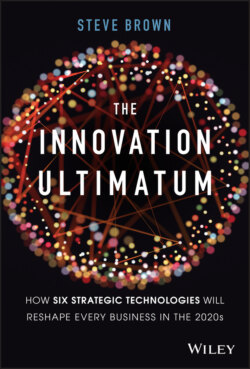Читать книгу The Innovation Ultimatum - Steve Brown - Страница 38
Creating and Co-Creating Content
ОглавлениеComputers now have the capacity for imagination. Artificial intelligence can compose music, paint pictures, and even write poetry. AI also co-creates content with humans: a partnership of digital intelligence with artists, designers, and engineers.
Most AIs create content using a relatively new AI approach known as Generative Adversarial Networks (GANs). The first GAN was built in 2014 by Ian Goodfellow, then a researcher at the Université de Montréal and now part of the Google Brain project. GANs link two AIs together in a sophisticated version of reinforcement learning where each AI trains the other. The AIs operate in an adversarial context: Each tries to catch the other out. Here's how it works. One AI is trained to create content and the other AI is trained to spot fake/generated content. Think of these AIs as a forger and an art detective. The detective, known as the discriminator AI, is initially trained with many real-world examples of “good” data (real content). The forger, known as a generator AI, tries to fool the discriminator by creating high-quality, realistic content. At first, the content created by the generator AI is terrible and the discriminator easily spots it as “fake.” But the generator steadily improves until eventually the discriminator finds it harder to spot generated content. Over time, each AI gets better at its assigned task. While the relationship between the AIs is adversarial, the net result is that the discriminator acts as a coach to the generator AI, and the generator acts as a coach for the discriminator. Eventually, the generator AI creates incredible, high-quality content: images, videos, speech, music, prose, legal contracts, and engineering designs. GANs have even been used to automate the design of crowns for teeth.
GANs have incredible potential. They will fundamentally change the way we work. Within the next decade, many of you reading this book may partner with GAN-based AIs to co-create content and collaborate on business tasks.
While there are some worrying downsides to generative AI—most notably deepfakes—many applications offer incredible potential. The most powerful example of machines with an imagination today is generative design, a field pioneered by engineering design company Autodesk. Generative design is used extensively in engineering and architectural design. We discuss these applications further in Chapters 14 and 15. Generative design uses the imagination and content creation capabilities of GANs to generate hundreds or thousands of alternative design options from a single original design. Designers specify constraints—size, weight, cost, and so on—and the tool generates options and evaluates each one using simulation tools. The designer simply picks the option that best meets their needs—perhaps the one that's cheapest to make, easiest to manufacture, or has the lightest weight.
Generative AI will help to design lighter-weight aircraft, cars that are more resilient to crashes, and stronger, lighter robots. Generative architecture will improve the structural integrity and design of new buildings.
Researchers at the University of California, Berkeley, working in partnership with Glidewell Dental Lab, use GANs to design dental crowns. The AI uses digital x-rays of a patient's upper and lower jaw to design a crown that perfectly fills the gap in the patient's tooth line, optimizes bite contact, and looks aesthetically pleasing. Researchers claim that AI-generated crowns outperform those designed by humans. The approach should speed crown production, reduce costs, and free dentists to spend more time generating revenue by working in patients’ mouths, rather than designing crowns on a CAD machine in a back office.
Generative AI is an example of a broader category of AI that I refer to as “collaborative AI.” Collaborative AIs operate in partnership with humans in a creative process. Humanity's use of tools distinguishes us from most other species. Traditional tools are subordinate—we wield a hammer, drive a car, and program a computer. Collaborative AI changes our relationship with tools. They are no longer subordinate, they now co-create with us. Collaborative AIs aren't just tools, they're partners.
Collaborative AI will co-create visuals for presentations, advertisements, and marketing brochures. Collaborative email software will auto-compose responses. Collaborative management software will co-create plans for complex projects. Many job functions will benefit from collaborative AI in the coming years.
